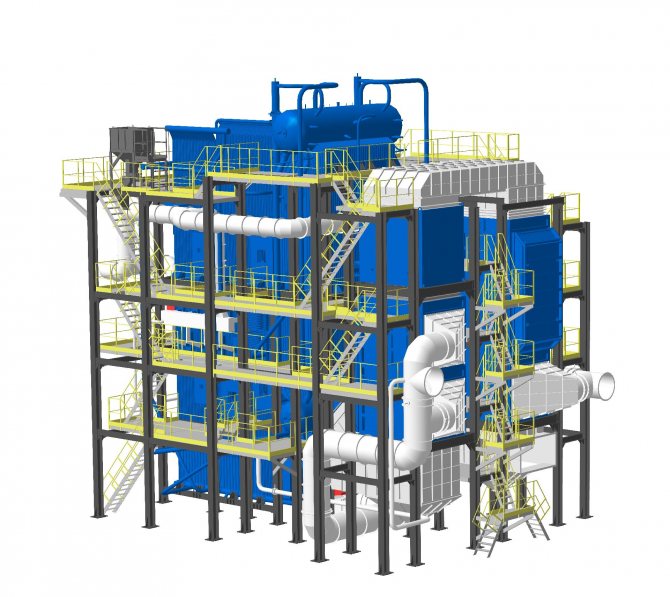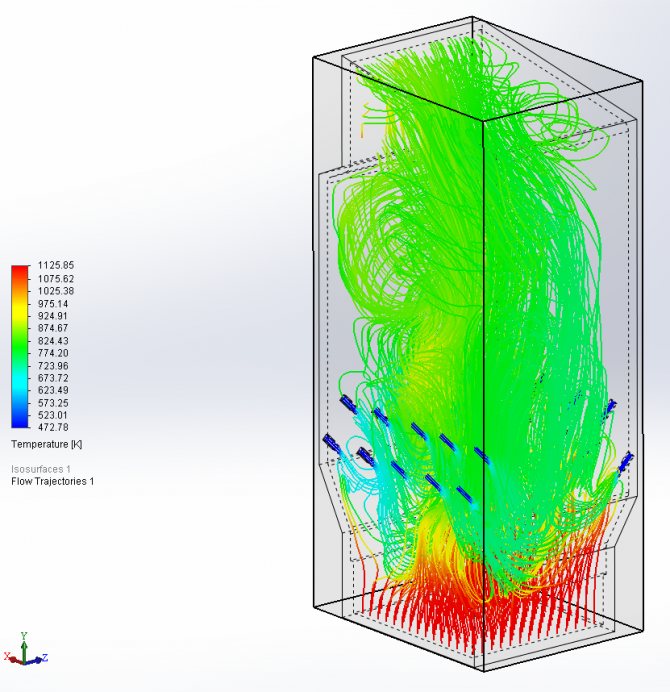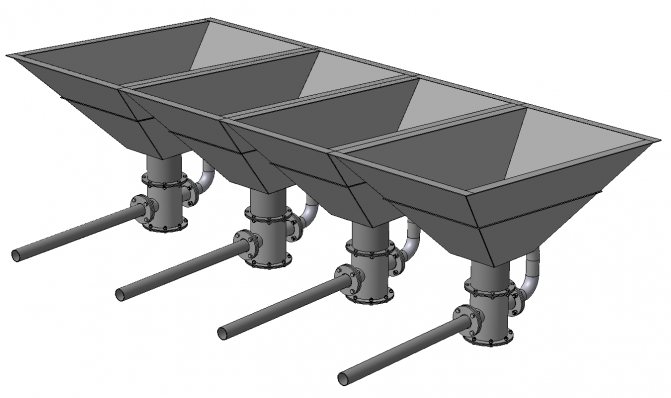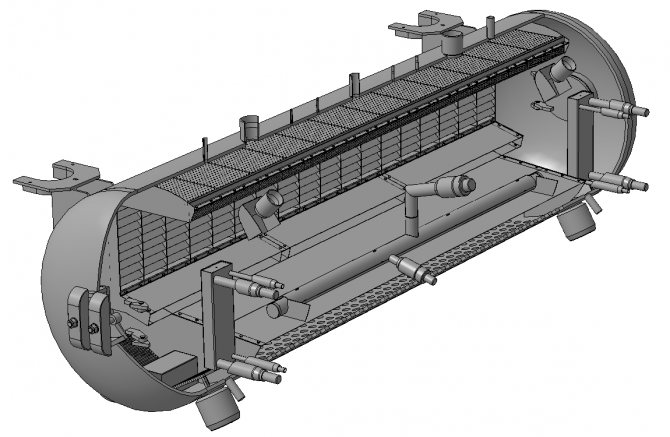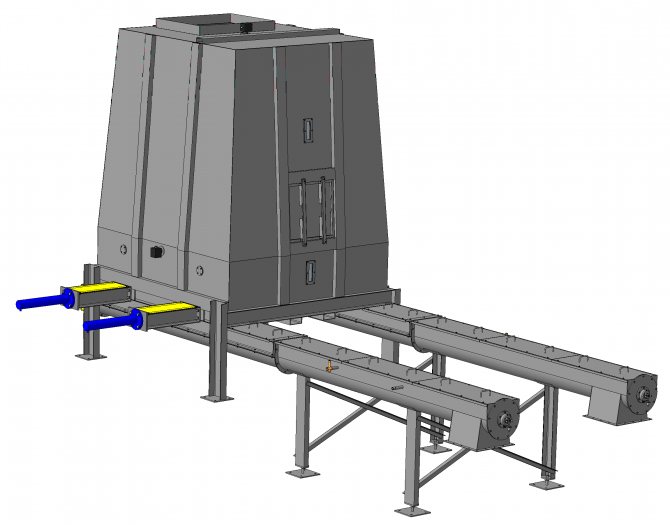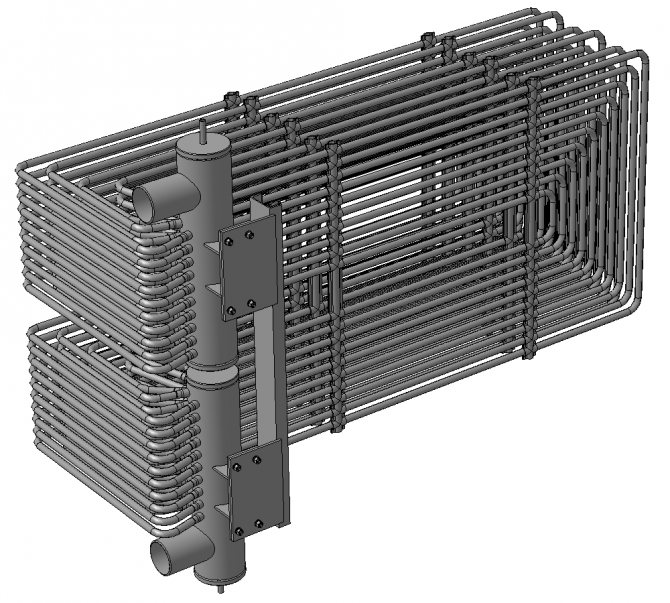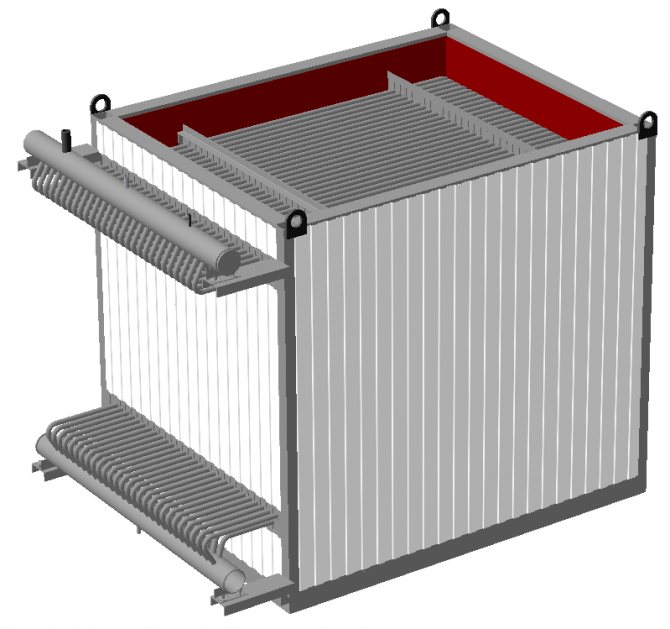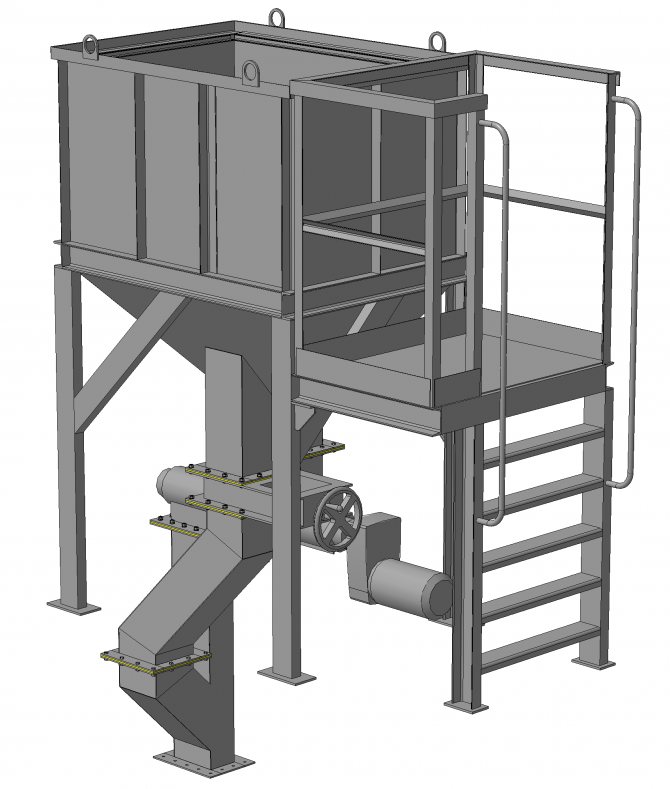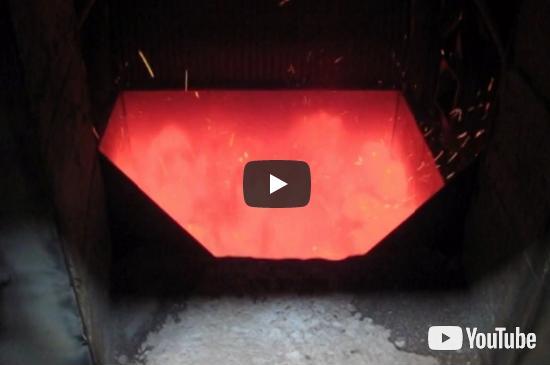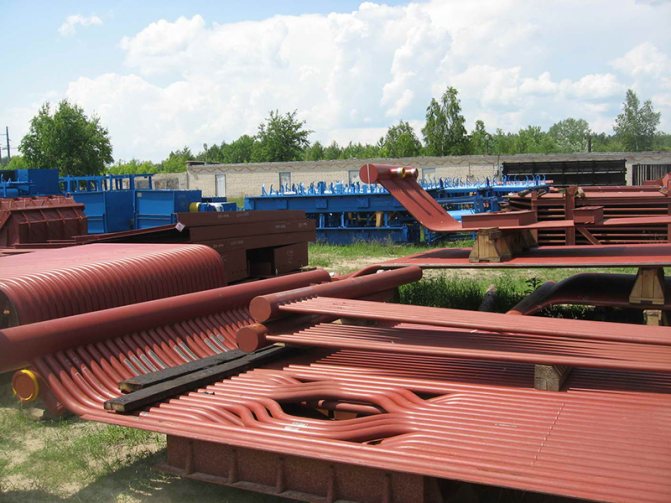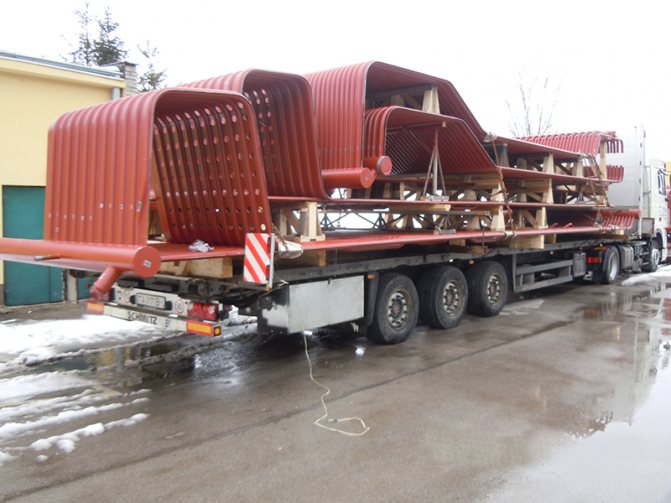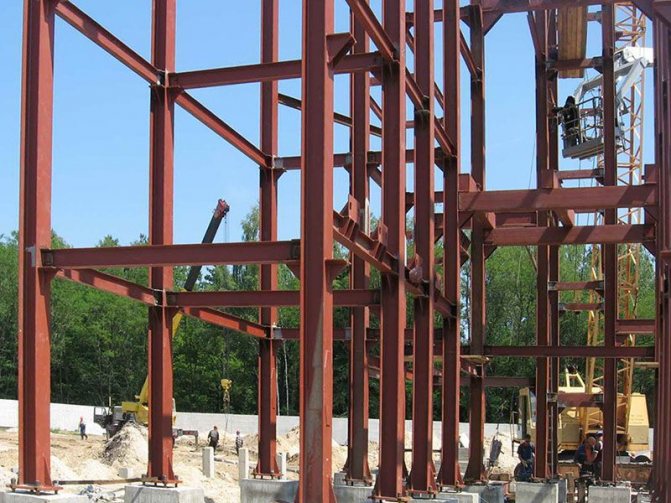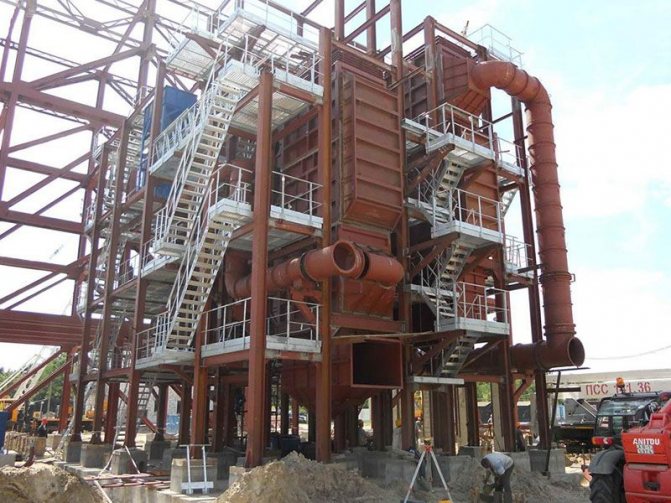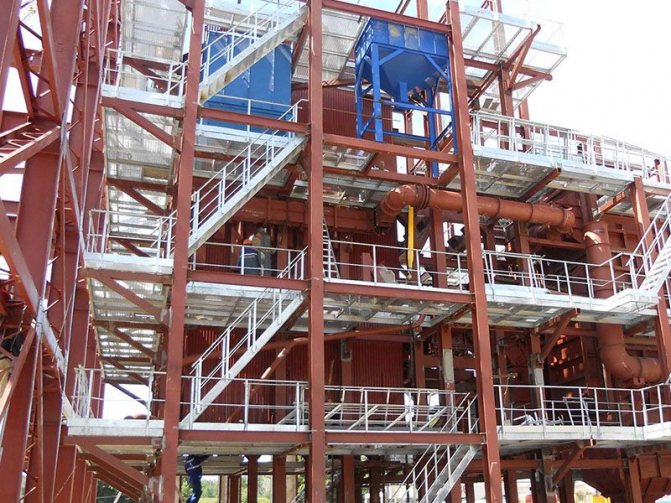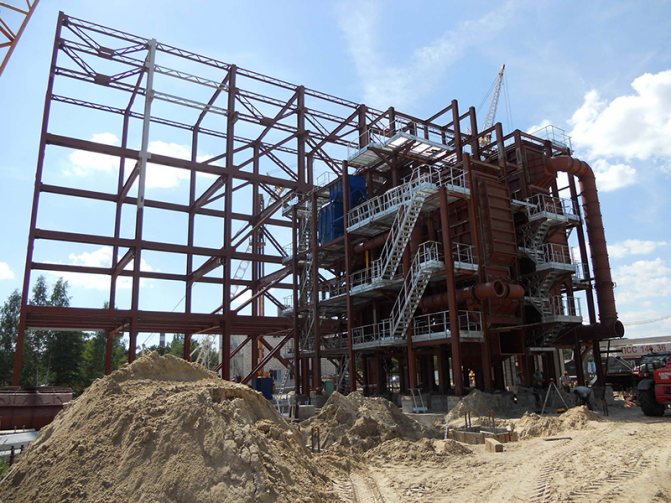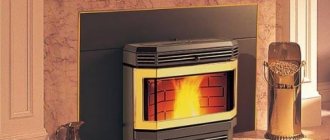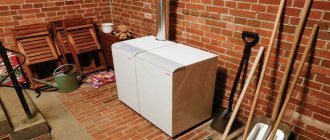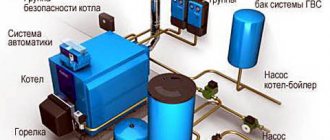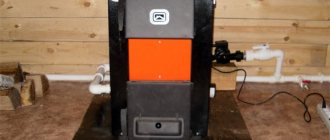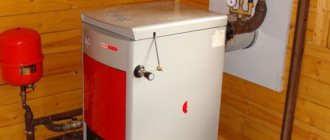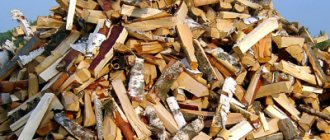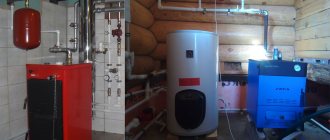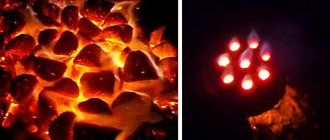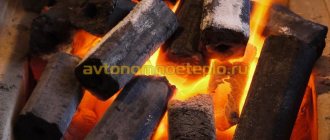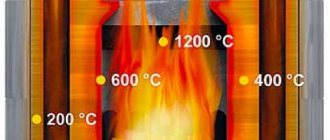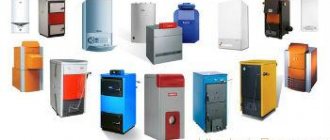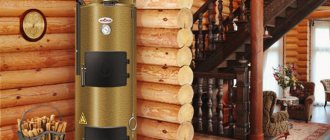Whatever the type of solid fuel boiler, all have a high level of efficiency, thanks to the design and principle of the device. On this page, we will consider and try to understand how solid fuel boilers work. The main difference between conventional solid fuel boilers and long burning solid fuel boilers is that in the second case, combustion takes much longer due to the combustion principle. So let's look at the principle of operation of solid fuel boilers and how solid fuel boilers work in order to understand how to choose a boiler.
The principle of operation of a long-burning solid fuel boiler.
Typically, these solid fuel boilers operate on the principle of "top combustion". How does a long burning boiler work? Before oxygen enters directly into the furnace, where combustion takes place, it is heated up. It is heated in order to ultimately reduce the amount of combustion waste: soot, ash. Oxygen is supplied not from bottom to top, but from top to bottom. Thus, only the top layer of solid fuel stored in the firebox burns. Due to the fact that the air enters from above, it does not penetrate downward and the combustion process is impossible there. Only the top layer of fuel burns. When the top layer burns out, feed to the bottom layer is turned on. So gradually, as the combustion progresses, the air is supplied lower and lower. Thanks to this approach, the top layer of fuel always burns, and the one below remains intact until it comes to its turn. This allows very economical consumption of fuel and control of the combustion process. It is with this technology that solid fuel burns for a very long time.
Such boilers are not only economical but also environmentally friendly. Of course, provided that fire-resistant building materials are used, which will not only ensure the maximum efficiency of the boiler, insulating heat, but also protect against possible fires.
You can clearly understand how the pyrolysis boiler works from this video:
For combustion of fuel in boilers, layer and flare combustion methods are mainly used.
Layered fuel combustion used for burning solid fuel on a grate. Air for fuel combustion is supplied under the grate. In this case, the fuel layer can occupy one of the following positions:
· Be stationary on the grate (Fig. 4 a). The fuel is fed to the grate with a shovel through a feed port, which is also used for slag removal. Air is fed under the grate and through the holes in the grate enters the fuel layer. Since the supply of fuel, the sanding of the layer, the removal of slag from the grate and ash from under the grate is done manually, such furnaces are called manually operated furnaces;
· Be stationary on the grate, the grate of which can be rotated to remove slag (Fig. 4b). The fuel is supplied by a rotary spreader. Such furnaces are called semi-mechanical;
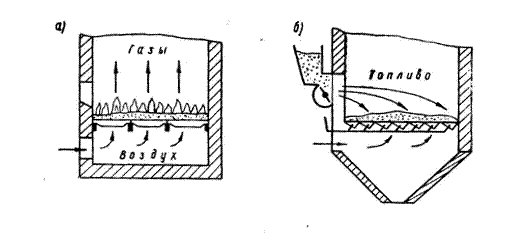
Fig. 4. Layered furnaces schemes:
a - manual firebox; b - semi-mechanical firebox.
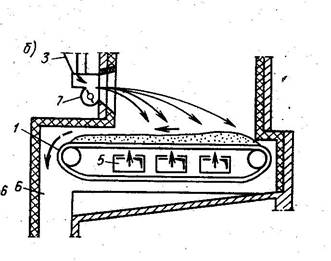

Fig. 5. Mechanical layered furnace diagram:
1 - movable backstop lattice; 3 - coal box; 5 - air channels; 6 - slag mine; 7 - rotary spreader.
· Move together with the belt chain grate at low speed towards the front of the boiler. Fuel is thrown onto the back of the movable grate and, as it moves, ignites, burns and turns into slag. Since the processes of fuel supply, bed maintenance and slag removal do not require manual labor, such furnaces are also mechanical (Fig. 5);
· Be suspended above the grate, which creates a high-pressure air flow (up to 10 kPa). The air is introduced into the bed and its uniform distribution over the section of the furnace is carried out by a steel grate with air caps. Lumps of coal make a lifting and lowering movement and burn in a suspended state, and ash falls on the grate. To avoid slag melting, the layer is cooled by a submerged heating surface to temperatures not exceeding 800-950 ° C. Such a bed is called a low temperature fluidized bed. In a fluidized bed, the processes of carbon oxidation are significantly improved, which allows high-quality combustion of high-ash coals with a content of mineral impurities of up to 50 - 70% with full mechanization of the furnace operation.
Fig. 6. Scheme of a fluidized bed furnace:
1 - ash bin; 2 - air distribution grille; 3 - submerged heating surface; 4 - fluidized bed of fuel.
Fuel flaring(rice. 7) .The flare method burns flammable gases, liquid fuels and finely divided solid fuels. Devices that introduce fuel and air into the furnace and ensure their mixing are called burners.
Fig. 7. Fuel flare scheme
Fuel particles burn on the fly, moving through the firebox together with the flow of air and gases. Compared to layered furnaces, fuel particles stay in the furnace for a limited time, the fuel supply in the furnace is small, as a result of which the combustion process is sensitive to any changes in the operating mode of the furnace. So, for example, with an excessive increase in the air flow rate during gas combustion, the flame may detach from the torch and the torch may be extinguished.
Furnaces for flare combustion of fuel are called chamber furnaces, and depending on the type of fuel - gas-oil or pulverized coal.
Burning fuel torch has high heat radiation. Therefore, to protect the walls of the furnace from destruction by heat flux, radiation heating surfaces (screens) are installed along the walls.
How does a pyrolysis boiler work. The device and principle of operation of the pyrolysis boiler.
The principle of operation of a pyrolysis solid fuel boiler is based on the process of decomposition of solid fuel into pyrolysis gas and coke. This is achieved by insufficient air supply. Due to the weak air supply, the fuel smolders slowly, but does not burn, as a result pyrolysis gas is formed. As a result, the gas combines with air. combustion occurs and heat is released, which heats the coolant. Thanks to this process, there are very few harmful substances in the smoke, and soot and ash are negligible. So in the case of pyrolysis boilers, you can also talk about environmental friendliness.
So, let's take a closer look at the principle of operation of a pyrolysis boiler.
- What is pyrolysis? Pyrolysis is a combustion process under conditions of insufficient oxygen. The result of such combustion is solid combustion products and gas: solid waste is ash and a mixture of volatile hydrocarbons plus carbon dioxide.
- The principle of operation of the gas generator(or pyrolysis boiler), is that such a solid fuel boiler divides the heating process into two processes. First, this is the usual process of burning solid fuel, while limiting the supply of oxygen. When there is a shortage of air, solid fuel smolders very slowly, releasing gas. It limits the oxygen supply, the boiler is very simple, with a mechanical damper, which, depending on the amount of air in the furnace, either opens or closes. In this case, you can manually "turn on the heat" by slightly opening the damper.
- Second part of the combustion process fuel, consists in burning out the volatile waste of the combustion process in the first furnace. In the second furnace, the so-called pyrolysis gas burns out - the result of burning solid fuel in the first furnace.
- Adjustment in this case, as in the case of air supply to the first furnace, it is very simple.The thermostat controls the combustion process and changes the operation of the boiler just as much as necessary to generate the required amount of heat. In principle, it does not differ much from a thermostat for a water heater.
- The efficiency of pyrolysis boilers. The most efficient boilers today are those in which combustion occurs from top to bottom. Of course, this imposes certain difficulties, for example, in such boilers, forced draft has to be done, because the second afterburner of pyrolysis gas is located under the grate. To put it simply: the fuel is scattered into the waste product of the combustion process - into ash. In this case, gas is formed, which is also afterburned. The result: maximum heat release, with virtually waste-free combustion. Plus, the ash can be used as fertilizer.
The principle of operation of the pyrolysis boiler is designed in such a way that in addition to the most efficient combustion of fuel, we also have minimal waste from the combustion process... The main disadvantage is the price of pyrolysis boilers, but there are actually a lot of positive aspects:
- Minimum waste and minimal cleaning of the furnace, in comparison with other solid fuel boilers.
- Long battery life no additional loads due to economical air supply.
- Automation combustion process. The boiler itself regulates when to increase combustion and when to decrease.
- Large solid fuels suitable for such boilers, since in any case the afterburning of the fuel takes place almost completely.
Lecture On the topic: "Methods of fuel combustion in the boiler furnace"
1 TYPES OF FUEL
Solid fuel
- flammable substances, the main component of which is carbon. Solid fuels include coal and brown coal, oil shale, peat and wood. Fuel properties are largely determined by its chemical composition - the content of carbon, hydrogen, oxygen, nitrogen and sulfur. The same amounts of fuel give different amounts of heat during combustion. Therefore, to assess the quality of the fuel, its calorific value is determined, that is, the largest amount of heat released during the complete combustion of 1 kg of fuel (the highest calorific value is coal). Basically, solid fuels are used to obtain heat and other types of energy, which are spent on obtaining mechanical work. In addition, more than 300 different chemical compounds can be obtained from solid fuel with appropriate processing (distillation); processing brown coal into valuable types of liquid fuel - gasoline and kerosene - is of great importance.
Briquettes
Briquettes are solid fuel formed in the process of compressing waste from the woodworking process (shavings, chips, wood dust) as well as household waste (straw, husks), peat.
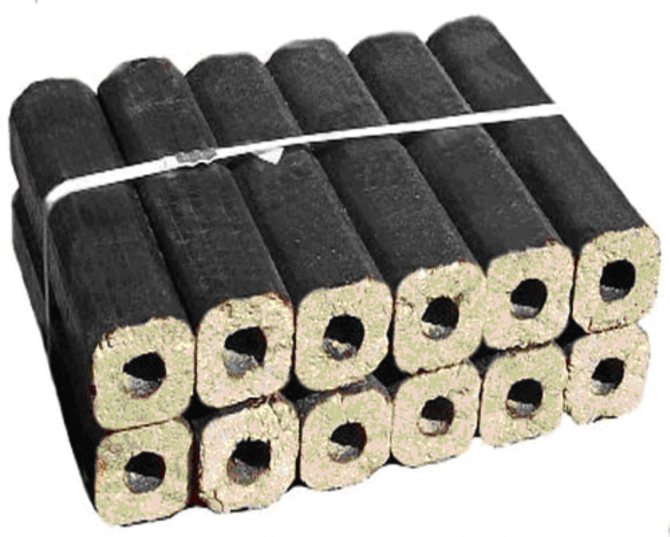

Fuel briquettes are convenient for storage, no harmful binders are used in the manufacture, therefore this type of fuel is environmentally friendly. When burning, they do not spark, do not emit foul gas, they burn evenly and smoothly, which ensures a sufficiently long combustion process in the boiler chamber. In addition to solid fuel boilers, they are used in home fireplaces and for cooking (for example, on the grill).
There are 3 main types of briquettes:
1. RUF briquettes. Formed rectangular bricks.
2. NESTRO briquettes. Cylindrical, can also be with holes inside (rings).
3. Pini & Kau - briquettes. Faceted briquettes (4,6,8 sides).
Advantages of fuel briquettes:
- Environmentally friendly.
- Long and convenient storage. Thanks to heat treatment, they are not affected by fungi. And thanks to the formation, they are conveniently used.
- Long and even burning is due to the high density of the briquettes.
- High calorific value. Almost twice as high as that of ordinary firewood.
- Constant combustion temperature.Due to the uniform density.
- Cost effective.
- Minimum ash content after burning: 1-3%
Pellets or fuel pellets.
Essentially the same production principle as for briquettes. Lignin (plant polymer) is used as a binder.
The materials are the same as for briquettes: bark, shavings, straw, cardboard. First, the raw material is crushed to the state of pollen, then, after drying, a special granulator forms granules of a special shape from the mass. Used in pellet heating boilers. Prices for this type of solid fuel are the highest - this is due to the complexity of production and popularity with buyers.
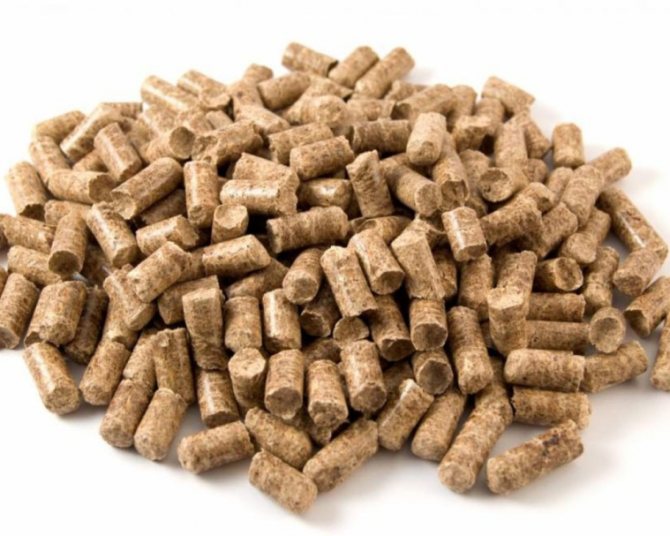

There are the following types of this solid fuel:
- Processing of round timber of hard and soft tree species into pellets.
- Peat pellets
- Pellets obtained from the processing of sunflower husks.
- Straw pellets
- The advantages of pellets:
- Environmentally friendly.
- Storage. Due to special production technologies, pellets can be stored directly in the open air. They do not swell, do not become covered with fungus.
- Long and even burning.
- Low cost.
- Due to their small shape, the pellets are suitable for boilers with automatic loading.
- Wide range of applications (boilers, stoves, fireplaces)
Firewood
Pieces of wood intended for obtaining heat by burning in boilers for heating with solid fuels, fireboxes intended for firewood. For convenience, the length of the logs is usually 25-30 cm. For the most efficient use, the lowest possible moisture level is required. For heating, combustion is required as slow as possible. Also, in addition to heating, firewood can be used, for example, in boilers for solid fuels. Deciduous species are best suited for these parameters: oak, ash, hazel, hawthorn, birch. Worse - coniferous firewood, as they contribute to the deposition of resin and have a low calorific value, while they quickly burn out.
Firewood is presented in two types:
- Sawed.
- Chipped.
2 FUEL COMPOSITION
For the formation of coal, an abundant accumulation of plant matter is necessary. In ancient peat bogs, starting from the Devonian period, organic matter accumulated, from which fossil coals were formed without oxygen. Most of the commercial deposits of fossil coal date from this period, although there are also younger deposits. The oldest coals are estimated to be about 350 million years old. Coal is formed when rotting plant material accumulates faster than bacterial decomposition occurs. An ideal environment for this is created in swamps, where stagnant water, depleted in oxygen, interferes with the vital activity of bacteria and thereby protects the plant mass from complete destruction? At a certain stage of the process, the acids released during the process prevent further bacterial activity. This is how peat is formed - the initial product for coal formation. If then it is buried under other sediments, then the peat undergoes compression and, losing water and gases, is converted into coal. Under the pressure of sediment layers 1 kilometer thick, a layer of brown coal 4 meters thick is obtained from a 20-meter layer of peat. If the depth of burial of plant material reaches 3 kilometers, then the same layer of peat will turn into a layer of coal 2 meters thick. At a greater depth, about 6 kilometers, and at a higher temperature, a 20-meter layer of peat becomes an anthracite layer 1.5 meters thick. As a result of the movement of the earth's crust, the coal seams experienced uplift and folding. Over time, the raised parts were destroyed due to erosion or spontaneous combustion, and the lowered ones remained in wide shallow basins, where coal is at least 900 meters from the earth's surface.
Brown coals.They contain a lot of water (43%) and therefore have a low calorific value. In addition, they contain a large amount of volatile substances (up to 50%). Formed from dead organic residues under load pressure and under the influence of elevated temperatures at depths of about 1 kilometer.
Coals. They contain up to 12% moisture (3-4% internal moisture), therefore they have a higher calorific value. They contain up to 32% volatile substances, due to which they are quite flammable. Formed from brown coal at depths of about 3 kilometers.
Anthracites. Almost entirely (96%) are carbon. They have the highest calorific value, but are poorly flammable. Formed from coal and in the form of HOX oxides. They refer to the harmful components of combustion products, the amount of which should be limited.
Sulfur - contained in solid fuels in the form of organic compounds SO and pyrite Sx, they are combined into volatile sulfur Sl. Sulfur is also included in the fuel in the form of sulphurous salts - sulfates - which are incapable of burning. Sulfate sulfur is usually referred to as fuel ash. The presence of sulfur significantly reduces the quality of solid fuels, since sulfurous gases SO2 and SO3 combine with water to form sulfuric acid - which in turn destroys the metal of the boiler, and getting into the atmosphere harms the environment. It is for this reason that the sulfur content in fuels - not only in solid ones - is highly undesirable.
Ash - fuel is a ballast mixture of various minerals remaining after the complete combustion of the entire combustible part of the city. Ash directly affects the quality of fuel combustion - it reduces combustion efficiency.
Questions:
1. What are the main types of solid fuels?
2. What is ash?
3 FUEL APPLICATION
The use of coal is diverse. It is used as a household, energy fuel, raw material for the metallurgical and chemical industries, as well as for the extraction of rare and trace elements from it. Liquefaction (hydrogenation) of coal with the formation of liquid fuel is very promising. For the production of 1 ton of oil, 2-3 tons of coal are consumed, some countries almost completely provided themselves with fuel due to this technology. Artificial graphite is obtained from coal.
Brown coal outwardly differs from bituminous coal in the color of a line on porcelain plastic - it is always brown. The most important difference from bituminous coal is its lower carbon content and significantly higher VOC and water content. This explains why brown coal burns more easily, gives more smoke, smell, as well as the aforementioned reaction with caustic potassium and produces little heat. Due to its high water content for combustion, it is used in powder, into which it inevitably turns during drying. The nitrogen content is significantly inferior to coal, but the sulfur content is increased.
The use of brown coal - as a fuel, brown coal is used in many countries much less than coal, however, due to its low cost in small and private boiler houses, it is more popular and sometimes takes up to 80%. It is used for pulverized combustion (during storage, brown coal dries up and crumbles), and sometimes the whole. In small provincial CHP plants, it is also often burned for heat. However, in Greece and especially in Germany, brown coal is used in steam power plants, generating up to 50% of electricity in Greece and 24.6% in Germany. The production of liquid hydrocarbon fuels from brown coal by distillation is spreading at a high speed. After distillation, the residue is suitable for the production of soot. Combustible gas is extracted from it, and carbon-alkali reagents and methane-wax (mountain wax) are obtained. In scanty quantities, it is also used for crafts.
Peat is a combustible mineral formed in the process of natural withering away and incomplete decay of marsh plants in conditions of excessive moisture and difficult air access. Peat is a product of the first stage of the coal educational process. The first information about peat as a "combustible soil" used for cooking dates back to the 26th century AD.
Sedimentary rock of plant origin, composed of carbon and other chemical elements. The composition of coal depends on age: anthracite is the oldest, coal is younger, and the youngest brown. Depending on aging, it has a different moisture content. The younger, the more moisture. Coal in the process of burning pollutes the environment, plus it is sintered into slag and deposited on the grates in the boiler. This prevents normal combustion.
Questions:
- Fuel application?
- Is fuel combustion harmful to the environment, and which type is the most
?
4 WAYS OF FUEL BURNING
There are three ways of fuel combustion: layer, flare or chamber and vortex.
1 - grate; 2 - igniter door; 3 - loading door; 4 - heating surfaces; 5 - combustion chamber.
Figure 4.1 - Layered furnace scheme
This drawing shows a layered method of fuel combustion, where a layer of lumpy fuel lies motionless on the grate and is blown with air.
The layered method is used to burn solid fuels.
And here is shown a flare and vortex method of fuel combustion.
1 - burner; 2 combustion chamber; 3 - lining; 4 - furnace screen; 5 - ceiling-mounted radiant steam superheater; 6 - scallop.
Figure 4.2 - Chamber furnace
Figure 4.3 - Vortex fuel combustion
With the flare and vortex method, all types of fuel can be burned, only solid fuel is preliminarily subjected to breaking, turning it into dust. When fuel is burned, all heat is transferred to the combustion products. This temperature is called the theoretical combustion temperature of the fuel.
In industry, continuous boilers are used to burn solid fuels. The principle of continuity is supported by a grate, to which solid fuel is constantly supplied.
For a more rational combustion of fuel, boilers are being built that are capable of burning it in a dusty state. Liquid fuels are burned in the same way.
Questions:
- What is the most rational combustion method?
- Explain the advantages of the chamber combustion method.
5 OPERATING PROCESSES IN BOILERS
Working processes in boilers:
- Steam formation
- Corrosion of heating surfaces
In boiler plants, such processes as the formation of steam take place:
- The conditions under which steam is formed in boilers are constant pressure and continuous heat supply.
- Steps in the vaporization process: water heating to saturation temperature, vaporization and steam heating to a predetermined temperature.
Even in boilers, one can observe the corrosion of heating surfaces:
- The destruction of metal under the influence of the environment is called corrosion.
Corrosion from the side of combustion products is called external, and from the side of the heated medium - internal.
There is low temperature and high temperature corrosion.
To reduce the destructive force of corrosion, it is necessary to monitor the water regime of the boiler. Therefore, raw water is pretreated before being used to power boilers in order to improve its quality.
Boiler water quality is characterized by dry residue, total salt content, hardness, alkalinity and content of corrosive gases
- Sodium cation filter - where the water is purified
- Deaerator - aggressive agents, air oxygen and carbon dioxide are removed.
- Samples of pipes that have corroded outside and inside.
Corrosion of heating surfaces
Internal corrosion of steam and hot water boilers is mainly of the following types: oxygen, steam-water, alkaline and sub-sludge.
The main appearance of oxygen corrosion is ulcers, usually with iron oxides.
Steam-water corrosion is observed during the operation of boilers with increased thermal loads. As a result of this corrosion, on the inner surfaces of the wall tubes and brittle damage in the places where the boiler water is evaporated.
Pits are formed as a result of undersludge corrosion.
External corrosion can be low temperature and high temperature.
Low temperature corrosion can occur when any fuel is burned. High-temperature corrosion can occur when burning fuel oil.
Automation and mechanics of solid fuel boilers.
Despite all levels of control over combustion processes and operational safety in general, solid fuel boilers practically do not contain complex automatic devices. Due to the fact that most often the temperature is regulated by mechanics, there is practically nothing to break in boilers. In addition, the design of the boilers itself is simple and reliable. Therefore, it is realistic to do the installation of a solid fuel boiler with your own hands, but it is better to contact a specialist. You can even make a boiler room with your own hands, but why unnecessary problems if you can entrust everything to professionals?
Furnace devices
Furnace devices
The following combustion devices are used in boiler units: for furnace combustion and for chamber combustion. These combustion devices can be very different in design, associated with the characteristics of the fuel - the release of volatiles, ash content, moisture content, lump size, slag properties, sulfur content in the fuel, etc.
Layer combustion of pieces of solid fuel is carried out by a grate located in the volume of the furnace, and the air necessary for fuel combustion enters under the grate.
Chamber combustion devices carry out combustion in a suspended state in a stream of air (solid in a pulverized state), and the air required for combustion is supplied to the same volume. The volume intended for combustion of all or part of the fuel is called the combustion chamber (chamber) and is denoted by Vt. The combustion device is usually characterized by its thermal power, grate area R and the volume of the combustion chamber. The amount of heat released in the combustion device during an hour is called power, MW or kcal / h, and is determined from the expression
Layer combustion devices distinguish between the total area of the grate R and the "combustion mirror" Rz.g. In furnaces with a fixed grate usually R = Rz.g. for furnaces with chain, obliquely pushing gratings, the area of the combustion mirror is less than the full area due to the presence of various devices.
The operation of a layered furnace can be estimated by the value of the apparent thermal stress of the grate or combustion mirror, kW / m2 or kcal / (m2-h):
that is, the amount of heat released per unit of time per unit of area.
The amount of heat released per unit time per unit volume of the combustion chamber is called the visible thermal stress of the combustion space and is determined from the expression, kW / m3 or kcal / (m3Xh):
For chamber furnaces, they also use the concept of the apparent thermal stress of the section of the combustion chamber Ftop, MW / m2 or Mcal / (m2Xh), defined as
where Ftop is the horizontal section of the chamber at the level of the burner axes, m2.
If the main fuel is ignited from a burning layer lying on the grate and a stationary burning layer, this ignition is called bottom ignition. If the fuel is ignited due to the radiation of the flame above the burning layer, then such ignition is called the top one.
In furnaces with a fixed grate, both types of fuel ignition take place; when the grate is moving, less efficient upper fuel ignition prevails.
Furnace devices for layered combustion of fuel are divided depending on the method of supply, the nature of the movement of fuel along the grate, movement of the grate and the state of the fuel layer. With a fixed bed of fuel, the absence of mechanisms for its movement along the length or width of the grate, the combustion device is the simplest; it is usually loaded with fuel manually and is called a manual firebox. Such a combustion device is used only for small boilers with a capacity of up to 1.16 MW (1 Gcal / h).
In accordance with the rules of Gosgortekhnadzor, all boiler - units with a capacity of more than 1.16 MW (2 t / h or more than 1 Gcal / h), intended for the combustion of solid fuel, must have mechanized combustion devices. This mechanization can encompass the supply of fuel to the bunker located above the combustion device, the supply of fuel to the grate and its movement along the latter.
Intermediate between layer and chamber furnaces for burning solid fuel are furnaces with a fluidized or "fluidized" bed of fuel. In them, a stream of air and gases acts on fine-grained fuel particles, due to which the fuel particles become mobile and move - circulation in the layer and volume. The speed of air and evolved gases should not exceed a certain value, upon reaching which the entrainment of fuel particles from the layer begins. The flow rate at which the particles begin to move - "boiling", is called critical. Such furnaces require the same size of fuel pieces. Layer furnaces are used for units with a heating capacity of up to 30 - 35 MW (25 - 30 Gcal / h); for larger boilers, furnaces with chamber combustion and preliminary fuel preparation are adopted. Before entering the chamber furnaces, the fuel is crushed to a particle size of several micrometers. The primary air transporting solid fuel has a lower temperature than the secondary air, and its amount is less than that required for combustion. Fuel and air are supplied to the chamber furnaces through special burners, the location of which on the walls of the combustion chamber can be different. Sometimes part of the secondary air is supplied in the form of a sharp blast through nozzles at high speeds to change the position of the flame in the combustion chamber.
For combustion of liquid fuel, chamber furnaces are used, on the walls of which nozzles with mechanical, air, steam or mixed atomization of fuel are placed from the front or opposite. The air necessary for the combustion of the fuel is supplied to the device for installing the nozzle so that it flows as close as possible to the base (root) of the flame and to have a minimum excess of air; fuel oil is sometimes burned in combustion chambers with pre-furnaces - cyclones. The gaseous fuel is burned in chamber furnaces using various types of burners. The latter are distinguished by a number of features: gas pressure in front of the burners - low, medium and high; design features; the nature of the mixing - partial or complete - of gas and air in the burners; by the method of gas and air supply: single-wire - with only gas supply and two-wire - when gas and air are introduced into the burner through special pipes and ducts; by the nature of the flame - luminous or weakly luminous and by the length of the torch - long or short.
Usually in chamber furnaces it is required to provide combustion of two types of fuel - solid and liquid, liquid and gaseous, solid and gaseous. As a result, the burners are structurally performed for the most part in such a way as to be able to set their minimum number, that is, they make them combined for two or even three types of fuel.Chamber furnaces are made for boilers of almost any capacity.
All combustion devices, according to their position relative to the boiler unit, were previously divided into internal, lower and remote ones. In modern units, combustion chambers are made with the maximum possible shielding.
Automated boilers with mechanical fuel supply
and fractional composition.
The influence of the moisture content of woody biomass on the efficiency of boiler plants is extremely significant. When burning absolutely dry woody biomass with low ash content, the efficiency of the boiler units, both in terms of their productivity and efficiency, approaches the efficiency of boiler units running on liquid fuel (boilers running on diesel fuel, fuel oil, etc.) and in some cases surpasses the operating efficiency boilers using some types of coal.
An increase in the moisture content of woody biomass inevitably leads to a decrease in the efficiency of boiler plants. With an increase in humidity, the lower heat of combustion decreases rapidly, fuel consumption increases, and combustion becomes more difficult. With a moisture content of 10% and an ash content of 0.7%, the net calorific value will be 16.85 MJ / kg, and with a moisture content of 50%, only 8.2 MJ / kg. Thus, the fuel consumption by the boiler at the same power will change by more than 2 times when switching from dry fuel to wet fuel. You should be aware of this and constantly develop and carry out measures to prevent the ingress of atmospheric precipitation, soil water, etc. into the wood fuel.
The ash content of woody biomass makes it difficult to burn. The presence of mineral inclusions in woody biomass is due to the use of insufficiently perfect technological processes of timber harvesting and its primary processing. It is necessary to give preference to such technological processes in which the contamination of wood waste with mineral inclusions can be minimized.
The fractional composition of the crushed wood should be optimal for this type of combustion device. Deviations in particle size from the optimum, both upward and downward, reduce the efficiency of the combustion devices. Chippers used to chop wood into fuel chips should not show large deviations in particle size towards their increase. However, the presence of a large number of too small particles is also undesirable.
Obtaining fuel savings in boiler houses operating on wood waste depends on how much the maintenance personnel ensures the timely qualified development and implementation of measures for the efficient and economical operation of boiler units based on knowledge of the specific features of woody biomass, considered as fuel.
Low-temperature fluidized bed steam boilers 10-50 tons / hour
Description
Advertising brochure - Steam boilers with furnace NTKS
Presentation - Equipment for
highly effectiveuse of
biomass at
production of heat and electricity
Steam boilers with a combustion chamber of a low-temperature "fluidized" bed (NTKS) are designed for combustion of various biological fuels (wood chips, milled peat, lignin, etc.) and are intended for the production of superheated steam, pressure from 14.0 to 39.0 bar and superheat temperature up to 440ºC. Superheated steam can be used to generate electricity, as well as for technological and economic needs of the Consumer.
- steam capacity: from 10.0 to 50.0 tons / hour;
- operating pressure: from 14.0 to 45.0 bar;
- overheating temperature: up to 440 ºС;
- efficiency factor: not less than 87%.
|
Furnace devices with layered fuel combustion include an inclined push grate, chain grate, etc. The combustion device of boilers with NTKS has a number of advantages in comparison with traditional combustion devices, namely:
- High efficiency - not less than 87%
In boilers with a NTKS furnace, the process of highly efficient fuel combustion with a high degree of automation is organized, which allows achieving maximum efficiency when burning biomass. The confirmed efficiency in boilers with NTKS is not less than 87%, which is practically unattainable in boilers with layered fuel combustion.
- Low emission of pollutants
The process of zone combustion of fuel is organized on inclined push gratings. In the first zone, thermal preparation and ignition of fresh fuel takes place, in the second zone there is active combustion, in the third - afterburning of the combustible components of the fuel. It is very difficult to organize a stable process and a uniform layer over the entire area of the grill. The supply of primary air is also carried out under the grill zone by zone, and requires the control of the air of each zone. However, these furnaces are very sensitive to the granulometric composition of the combusted fuel and changes in its thermal characteristics. With an increase in the composition of the burned fuel of fine fractions, a decrease in its moisture content or the speed of movement along the grate, the ignition zone moves in the direction of the front wall of the furnace. Early ignition of the fuel, accompanied by intense release of volatile substances, causes a significant increase in heat loss with chemical underburning of the fuel and a decrease in the efficiency and reliability of the furnace and the boiler as a whole. All these factors ultimately lead to poor environmental performance and high emissions of pollutants in the exhaust gases.
In boilers with a NTKS furnace, there is no division into zones, all the processes of ignition and combustion of fuel occur uniformly in the entire volume of the layer of inert material, the temperature of which can be controlled and precisely maintained in a given range. Primary air is supplied from below under the entire grille. The boiling of the sand layer contributes to a constant high-quality mixing and uniform distribution of fuel throughout the entire volume of the layer. The whole process is automated. All NTKS furnaces undergo preliminary computer simulation of combustion processes. All these factors result in good environmental performance and low emissions of pollutants in the flue gas.
- No need for preliminary fuel preparation
In boilers with a NTKS furnace, there is no need for preliminary drying of fuel, briquetting, pelletizing, etc., while combustion in layered furnaces has a number of restrictions on the moisture content and fractional composition of the fuel.
- Possibility of burning a mixture of different fuels
In boilers with NTKS furnaces, it is possible to burn a mixture of various fuels. It does not matter the different ignition temperature, the difference in moisture content and the burning time of different fuels in the mixture.
Combustion of a mixture of various fuels on the grates is problematic, since each type of fuel requires its own grate length, its own grate speeds, etc., therefore, the combustion of a mixture of various fuels on the grate will occur with a decrease in efficiency and an increase in pollutant emissions.
- Lack of mechanical components in the combustion device
There are no mechanical assemblies in the NTKS combustion device. During the operation of the boiler, there is no need for periodic repairs of mechanical components, replacement of abraded elements, the combustion device is designed for the entire service life of the boiler.
Fireplaces with layered fuel combustion imply the presence of grates, chain, oblique-pushing, etc., which contain mechanical units, require periodic repairs, replacement of worn out elements, replacement of grates, etc. All this increases operating costs and shortens overhaul intervals.
- Simple design, low cost
The NTKS grate is formed by side screens of the furnace, into the pipes of which caps are welded to distribute the primary air. The design is very simple and reliable and has a low initial cost. Operating costs are limited to periodic replenishment of the sand layer due to abrasive wear and depend on the type of fuel used. Estimated consumption - up to 120 kg / day.
Layered combustion grates are very complex in design, have a high metal consumption, and therefore a high initial cost and high operating costs.
- Small area of the mirror combustion grating NTKS
NTKS furnaces have a small area of the combustion mirror in comparison with layered combustion gratings due to the presence of a layer of sand and combustion of fuel in the entire volume of the layer. For example, the area of the NTKS grate in the section of a boiler with a steam capacity of 30 t / h is 11.5 m², while the area of the tilting-pushing grate will be approximately 32 m². This feature allows for a more rational boiler layout and achieving the maximum ratio of the boiler cell area to the installed equipment capacity.
- High degree of automation
Boilers with NTKS furnaces have a high degree of automation with continuous control and adjustment of the set parameters and allow automatic operation on various types of fuel, on various mixtures of fuels, to switch from one fuel to another without stopping the boiler with minimal participation of the maintenance personnel.
| When burning certain types of biofuels such as straw, cereal husks, etc. it is necessary to consider a number of features of this type of fuel The temperature of the onset of ash deformation, for example, for dry straw, is 735-840 ° C. This is the most basic problem to consider when choosing a boiler. This feature of crop waste as a fuel can lead to the formation of ash and slag agglomerates in the boiler furnace and on convective heat exchange surfaces with subsequent corrosion in the places of deposits and prevents combustion and normal operation of the boiler. The only correct solution to this problem is the organization of a controlled combustion process, which excludes the formation of high-temperature zones. In traditional furnaces with layered fuel combustion, such as tilt-push grate, chain grate, etc. so it is impossible to achieve this, in zones of intense combustion, local places with a high temperature exceeding the ash melting point are formed. In NTKS furnaces, fuel enters the intensively mixing inert material of the layer (quartz sand), being evenly distributed over the entire volume of the layer, the temperature of which can be controlled and precisely maintained in a given range. |
|
| When designing boilers, special attention is paid to computer modeling of combustion processes, which allows at the design stage to see problem areas and select the most optimal configuration of the furnace, achieve the best mixing of combustion products with air, and also optimally select places for entering secondary, and, if necessary, tertiary air, which in in turn, contributes to the organization of optimal combustion modes and low emissions of pollutants. |
|
|
|

